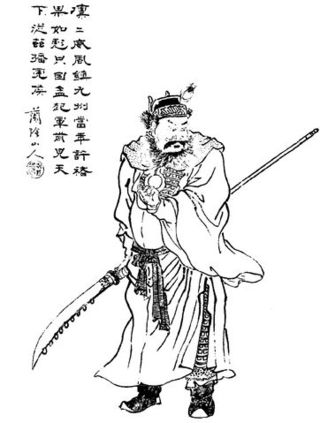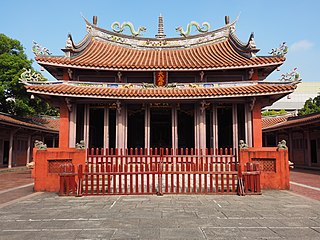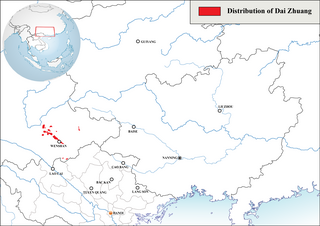
Điện Biên is a province in the Northwest region of Vietnam. It is bordered by Lai Châu to the northeast, Sơn La to the southeast, Pu'er City, Yunnan, China, to the northwest, and Phongsaly province in Laos to the west. The province covers an area of 9,541 square kilometres and as of 2019 it had a population of 598,856 people.

Xu Chu, courtesy name Zhongkang, was a Chinese military general who lived during the late Eastern Han dynasty and the Three Kingdoms period of China. He started his career as a bodyguard to the warlord Cao Cao and later became a general in the state of Wei during the Three Kingdoms period. He was described to be a big and strong man, yet simple minded and honest, so he was nicknamed "Tiger Fool" by his men. After his death, he was posthumously honoured with the title "Marquis Zhuang", which literally means "robust marquis".

Ba was an ancient state in eastern Sichuan, China. Its original capital was Yicheng, Hubei. Ba was conquered by Qin in 316 BC. The historical Bo people and the modern Tujia people trace some of their origins back to the people of Ba.

ChuChu was a Japanese shōjo manga magazine published by Shogakukan for 11–14-year-old girls. ChuChu became a monthly magazine in December 2005. On October 26, 2009, Shogakukan announced that it canceled ChuChu. It ended on December 28, 2009.
Kiyoko Haku, known by the pen name Kiyoko Arai, is a Japanese manga artist. She made her manga debut in the January 1984 issue of Ciao with her story Chotto dake Biyaku. Since then, Arai has contributed many stories to Ciao, its sister magazine ChuChu, and fellow Shogakukan shojo magazine Cheese!.

In pathology, Anitschkowcells are often cells associated with rheumatic heart disease. Anitschkow cells are enlarged macrophages found within granulomas associated with the disease.
The Pula or Phù Lá are an ethnic group of Vietnam and China. Most Pula live in Xichou County and Maguan County of Wenshan Prefecture of Yunnan and the bordering Lào Cai Province of the Northeast region of Vietnam. Their population in Vietnam is 12,471 in 2019. There are also approximately 4,200 Phù Lá in China, where they are classified as members of the Yi ethnic group.

The Tainan Confucian Temple or Quan Tai Shou Xue, is a Confucian temple on Nanmen Road (南門路) in West Central District, Tainan, Taiwan.

Mèo Vạc is a rural district of Hà Giang province in the Northeast region of Vietnam. As of 2019 the district had a population of 86 071. The district covers an area of 574 km². The district capital lies at Mèo Vạc.
Zhao Puchu was a religious and public leader who promoted cultural progress and religious tolerance in China. Zhao was best known as president of the Buddhist Association of China and also one of the most renowned Chinese calligraphers.

Dai Zhuang or Thu Lao is a Tai language spoken in Yunnan, China and northern Vietnam. In China is it spoken in Yanshan, Wenshan, Maguan, Malipo, Guangnan counties of Wenshan Prefecture. It is also spoken in Honghe Prefecture. The largest concentrations are in Wenshan and Yanshan counties.
Kháng, also known as Mang U’, is an Austroasiatic language of Vietnam. It is closely related to the Bumang language of southern Yunnan, China.
Vietnamese units of measurement are the largely decimal units of measurement traditionally used in Vietnam until metrication. The base unit of length is the thước or xích. Some of the traditional unit names have been repurposed for metric units, such as thước for the metre, while other traditional names remain in translations of imperial units, such as dặm Anh for the mile.

Hsieh Hsin-ta, professionally known as Chu Ke-liang was a Taiwanese comedian, actor, television show host and singer. He was known for his "over-the-top appearance" with unusual clothing and hair styles and his coarse humor.

Phạm Quỳnh was a monarchist during the late Nguyễn dynasty and supporter of adhering to traditional Vietnamese customs in the establishment of a constitutional monarchy. He was born near Hanoi, Vietnam, to a literati family of Hải Dương province. He was appointed Minister of Education to the royal court at Huế in 1932, and held several other posts in the court as premier and Minister of the Interior for Emperor Bảo Đại's government. He served as a government minister along with Ngô Đình Diệm under Emperor Bảo Đại's administration. After the August Revolution, he was killed by the Viet Minh along with two other high-ranking members of Bảo Đại's cabinet in September 1945.

Dream of the Emperor is a South Korean television series that aired on KBS1 from September 8, 2012 to June 9, 2013 on Saturdays and Sundays at 21:40 for 70 episodes.

The Six Provinces of Southern Vietnam is a historical name for the region of Southern Vietnam, which is referred to in French as Basse-Cochinchine. The region was politically defined and established after the inauguration of the Nguyễn dynasty, and called by this name from 1832, when Emperor Minh Mạng introduced administrative reforms, to 1867, which culminated in the eight-year French campaign to conquer the Six Provinces.
Sanfotsi, also written as Sanfoqi, was a trading polity in Southeast Asia mentioned in Chinese sources dated from the Song dynasty circa 12th century. In 1918, George Cœdès concluded that Chinese forms of San-fo-ts'i (Sanfoqi), Fo-ts'i (Foqi), Fo-che (Foshi), Che-li-fo-che (Shilifoshi), which correspond to Arabic Sribuza and can be reconstructed as Śribhoja, are names referring to the Srivijaya empire, located in Palembang, South Sumatra, in present-day Indonesia. After the Chola invasion of 1025, the term Sanfoqi has been proposed to refer to the Melayu kingdom, since the Chola invasion may have caused the disintegration of the Srivijaya mandala, and the mandala may have then re-centered in Jambi.

Chữ Hán, is the term for Chinese characters in Vietnamese. Chữ Hán are used to write Literary Chinese and Sino-Vietnamese vocabulary in the Vietnamese language. They were officially used in Vietnam after the Red River Delta region was incorporated into the Han dynasty and continued to be used until the early 20th century where usage of Literary Chinese was abolished alongside the Confucian court examinations causing chữ Hán to fall into obscurity.

The Yu Zisan Incident, also known as Yu Tse-san Incident, was a series of political events ignited by the death of Yu Zisan, then 23-year-old chairman of the Students' Autonomous Association (SAA) at National Che Kiang University (NCKU) during the Chinese Civil War. Suspected of links with communist factions, Yu was detained on 25 October 1947 at Hangzhou Garrison Headquarters and died there five days later. The Nationalist government asserted that Yu committed suicide fearing conviction, a claim the university did not endorse. His death, widely seen as a government effort to quell student activism, sparked widespread anti-government protests across China in November and December 1947.















